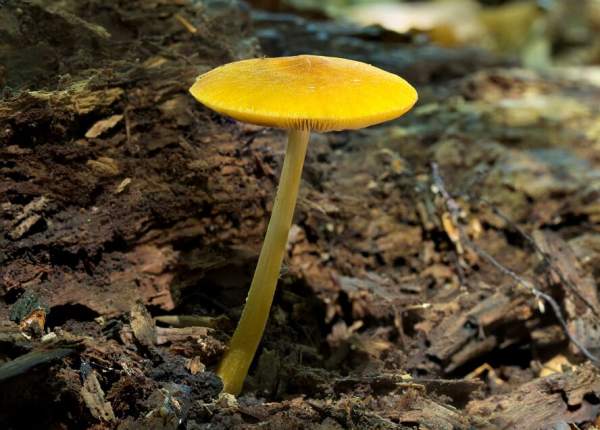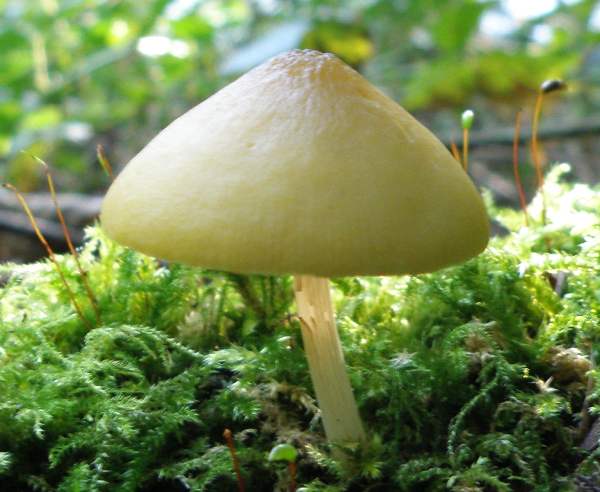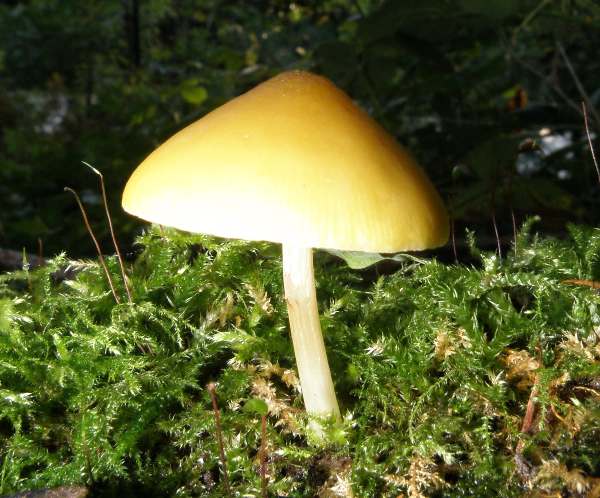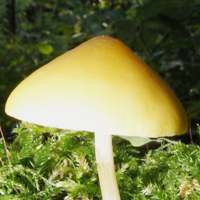Pluteus leoninus (Schaeff.) P. Kumm. - Lion Shield
Phylum: Basidiomycota - Class: Agaricomycetes - Order: Agaricales - Family: Pluteaceae
Distribution - Taxonomic History - Etymology - Identification - Culinary Notes - Reference Sources

The striking golden yellow cap of this medium-sized shield mushroom makes it easy to spot; however, its scarcity and its preference for dark, moist and well-shaded sites means that its appearance on the species lists from fungus forays is an all too infrequent occurrence.

Distribution
Widespread but rather uncommon in Britain and Ireland, this wood-rotting mushroom is also found throughout most of mainland Europe and in northern Africa. I have found no reports of the Lion Shield occurring in Australia, but it is certainly recorded in many parts of North America.

Taxonomic history
This woodland mushroom was described in 1762 by German naturalist Jacob Christian Schaeffer, who gave it the binomial scientific name Agaricus leoninus (at a time when most gilled fungi were placed in the genus Agaricus, since largely redistributed to newer genera). It was another German mycologist, Paul Kummer, who in 1871 transferred this species to its current genus, renaming it Pluteus leoninus, which is the scientific name by which mycologists generally refer to the Lion Shield to this day.
Synonyms of Pluteus leoninus include Agaricus leoninus (Schaeff.), Agaricus sororiatus P. Karst., and Pluteus sororiatus (P. Karst.) P. Karst.
Etymology
Pluteus, the genus name, comes from Latin and literally means a protective fence or screen - a shield for example! The specific epithet leoninus simply means 'like a lion', a reference to the colour rather than any other features of this rare woodland fungus!
Identification guide
 |
Cap3 to 5 cm across, convex, developing a slight umbo but never fully flattening; smooth and finely velvety; margin only slightly striate (more visible when wet); golden-yellow with a slightly darker centre. |
GillsFree; crowded; white, often with yellowish edges, turning pink as the spores mature. Stem4 to 7 cm long and 3 to 6mm diameter; smooth or slightly fibrillose; white background flushed with yellow, darkest near the base; no stem ring. |
|
SporesBroadly ellipsoidal or subspherical, smooth, 6-8 x 5-6µm. Spore printPink. |
|
Odour/taste |
Not distinctive. |
Habitat & Ecological role |
In common with other shield mushrooms, this is a wood-rotting (saprobic) fungus. Fallen hardwood trunks and large branches that have been left to rot and gather moss for several years appear to be the Lion Shield's staple diet. These beautiful mushrooms tend to be either solitary or at best they occur in very small groups. |
Season |
Fruiting from early summer to late autumn. |
Similar species |
Pluteus cervinus is usually larger and has a smooth brown or fawn cap. Pluteus chrysophaeus has a bright yellow cap but it is usually much smaller than Pluteus leoninus and does not have a darker central region. |
Culinary Notes
The Lion Shield is not known to be an edible mushroom, and in view of its rarity I recommend that this mushroom should not be gathered for eating.
Reference Sources
Fascinated by Fungi, 2nd Edition, Pat O'Reilly 2016, reprinted by Coch-y-bonddu Books in 2022.
Alfredo Justo, Andrew M. Minnis, Stefano Ghignone, Nelson Menolli Jr., Marina Capelari, Olivia Rodríguez, Ekaterina Malysheva, Marco Contu, Alfredo Vizzini (2011). 'Species recognition in Pluteus and Volvopluteus (Pluteaceae, Agaricales): morphology, geography and phylogeny'. Mycological Progress 10 (4): 453–479.
Orton, P.D. (1986). British Fungus Flora: Agarics and Boleti. Vol 4. Pluteaceae: Pluteus & Volvariella. Royal Botanic Garden: Edinburgh, Scotland.
Funga Nordica: 2nd edition 2012. Edited by Knudsen, H. & Vesterholt, J. ISBN 9788798396130
BMS List of English Names for Fungi
Dictionary of the Fungi; Paul M. Kirk, Paul F. Cannon, David W. Minter and J. A. Stalpers; CABI, 2008
Taxonomic history and synonym information on these pages is drawn from many sources but in particular from the British Mycological Society's GB Checklist of Fungi.
Acknowledgements
This page includes pictures kindly contributed by Wayne Hicks.
Fascinated by Fungi. Back by popular demand, Pat O'Reilly's best-selling 450-page hardback book is available now. The latest second edition was republished with a sparkling new cover design in September 2022 by Coch-y-Bonddu Books. Full details and copies are available from the publisher's online bookshop...

